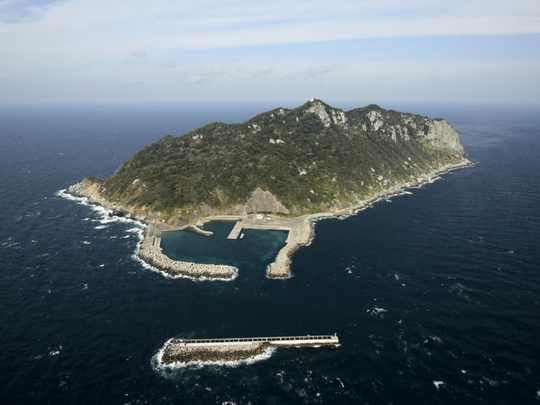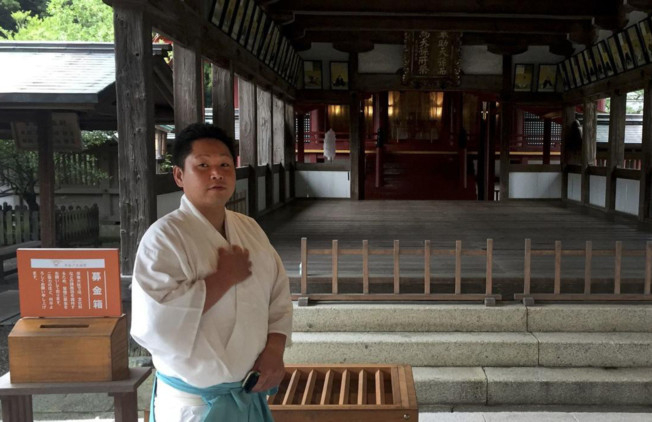
MUNAKATA, Japan
Okinoshima is a sacred island in the Sea of Japan, shrouded in mystery and strewn with ancient treasures.
For centuries, the island was forbidden to all but about 200 men, who could wade ashore only one day a year after “purifying” themselves, naked, in the freezing sea. Women were banned. Photographs were banned. Even talking about a visit to the island was long verboten.
Then, in July, after a yearslong lobbying effort by Japanese officials, the United Nations Educational, Scientific and Cultural Organisation (Unesco) declared Okinoshima a World Heritage site, placing it alongside more than 1,000 high-profile attractions including the Taj Mahal, Machu Picchu and the Great Wall of China.
The designation alarmed the keepers of Okinoshima’s tradition and raised questions about how communities keep traditions intact — and secrets secret — in the modern world.
Local fishermen, the island’s traditional guardians, wrung their hands. What if tourists flood the island? What if they steal its treasures, or cover it in trash? What if women come ashore?
Shinto religious leaders in Munakata, a sleepy municipality on the Japanese island of Kyushu of 100,000 that administers the smaller island, however, pre-empted their concerns. Rather than opening Okinoshima to the masses, they closed it to everyone except for roughly two dozen Shinto priests. They stay for 10 days at a time to pray and keep watch for intruders.
Talking taboos
Yoshihiro Suzuki, 32, is one of them. “On Okinoshima there are so many taboos, and so many forbidden things,” he said. “The idea is, this is a sacred place. Do not come in.”
Like many things about Okinoshima, its history is elusive. The island belongs to a system of three Shinto shrines, together called the Munakata Taisha. They are mentioned in the Nihon Shoki, a historical record of Japan completed in the year 720.
“So we know for sure that around that time the shrine was already here,” Suzuki said. “But before that, we don’t know anything.”
The story of the shrines begins with Amaterasu, the Shinto deity of the universe. When Amaterasu’s three daughters came to Earth, the legend goes, they landed on three islands: Kyushu (Japan’s third-largest island), Oshima (just offshore), and Okinoshima (about 48 kilometres out to sea, toward Korea). Locals built the shrines to worship them.
Okinoshima is lush yet austere, a few emerald green hills ringed by escarpments that plunge into the sea. It has an area of 0.77 of a square kilometre, a bit larger than a typical 18-hole golf course, and its highest point rises about 243 metres, making it visible from afar.
The island’s deity, according to local lore, guarded a well-travelled sea route to Korea, and local fishermen gave her offerings for safe passage: swords, flat iron ingots, golden looms, elaborate mirrors and bronze dragon heads. They covered the items with stones or scattered them in the shadows of boulders.
In the early 17th century, a Christian feudal lord, Kuroda Nagamasa, heard about the treasures. The locals refused to relinquish them, warning of a “divine curse”, so Nagamasa dispatched a Christian to retrieve them and stored them in a tower of his castle. But according to local lore, the tower soon began rumbling, and shiny objects streaked across the sky. His realm was racked by natural disasters and disease. So Nagamasa ordered the treasures back to the island, and normality returned.
In 1954, as Japan was recovering from the Second World War, officials decided to renovate the deteriorating Munakata shrines — and over the next two decades, oversaw three large-scale excavations on Okinoshima, assembling tens of thousands of the treasures. They took the artefacts back to the Munakata shrine on Kyushu, where many are now on display.
Flood of visitors
“Many questions linger about the large-scale rituals on Okinoshima including why they were performed there and who performed them,” Lindsey E. DeWitt, a Buddhism expert and visiting researcher at Kyushu University, wrote in a September blog post. “We only know with certainty what was left.”
Unesco critics say the World Heritage designation often brings a flood of visitors, turning sacred sites into tourist traps and cities into museums. Some call the phenomenon “Unesco-cide” — and it was this prospect that troubled the local fishermen.
“Those fishermen had a very strong belief regarding Okinoshima — that you should not transmit any information about it,” said Akifumi Kuba, Munakata city’s vice-mayor. “So they were very uncomfortable about Okinoshima becoming a World Heritage site.”
“It used to take hours for fishermen to get to Okinoshima, but now with speedboats, it takes only one to two hours,” added Tokunaga Atsushi, director of the city’s World Heritage Nomination Division.
“So we convinced the fishermen that because times have changed — and anyone can get to Okinoshima within a couple hours — the way you’ve been protecting the island may not be so successful anymore. Your way of protecting the island was to hide it. But from now on, we need to protect Okinoshima by explaining its importance and its value.”
The government has devoted more resources to promoting Okinoshima’s “associated sites”, especially the shrines on Kyushu and Oshima, called Hetsu-gu and Nakatsu-gu.
On a brisk autumn day, Oshima was almost empty, its streets devoid of cars.
Sixty-nine-year-old fisherman Toshiaki Okinishi, painted a picture of decline. Years ago, the waters around Okinoshima were full of fish, before overfishing left them depleted. Most of Oshima’s young people have moved away for work. In 1960, he said, the island had 1,200 residents; now it has 176.
Toshiaki Okinishi once feared Okinoshima’s World Heritage designation but now considers it a ray of hope. Perhaps it will bring tourists to Oshima, where they can visit a sacred shrine and peek at Okinoshima in the distance.
“When young people come to the island, they bring more energy,” he said. “The community becomes more lively. It’s good.”
—Los Angeles Times













